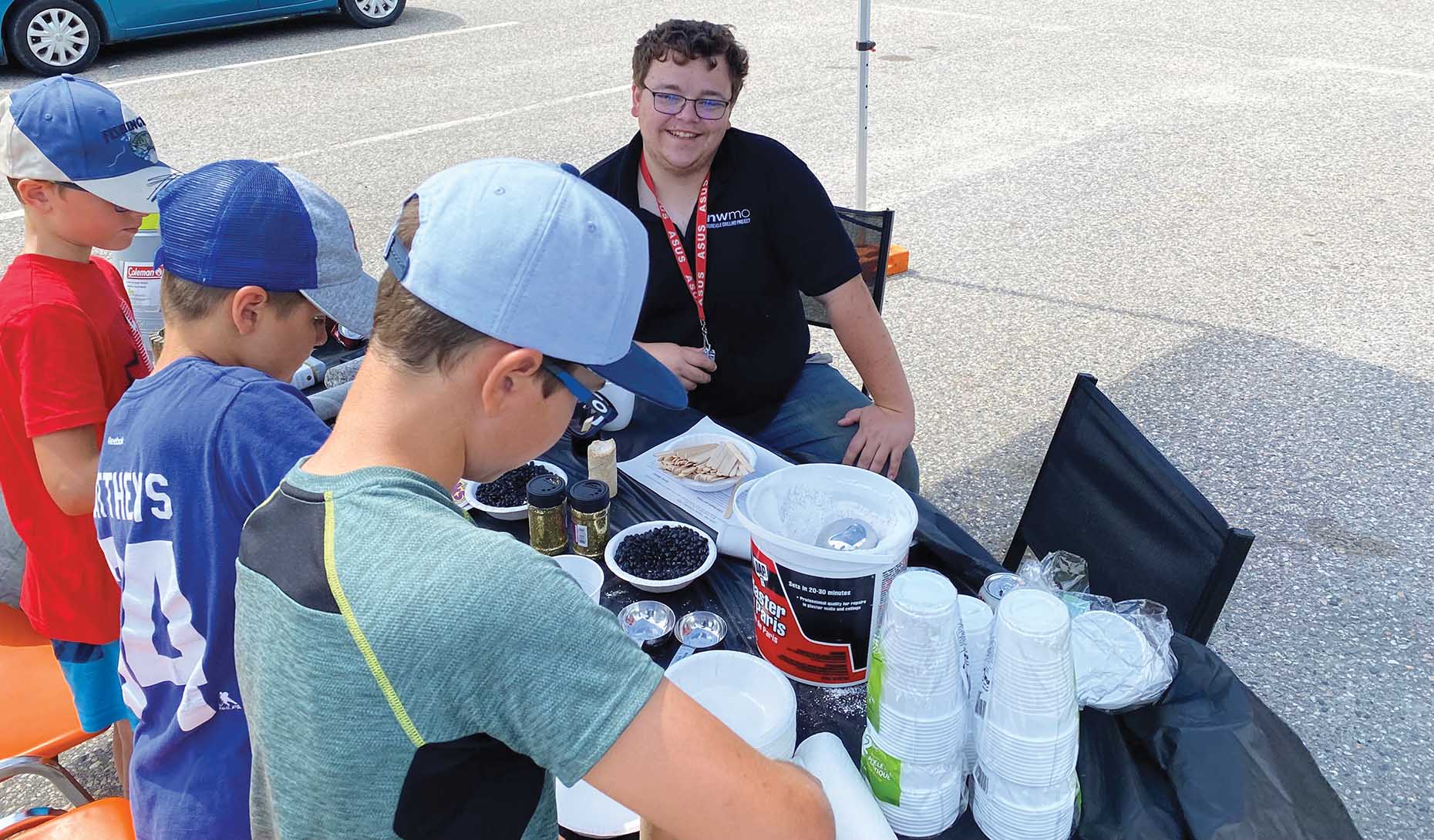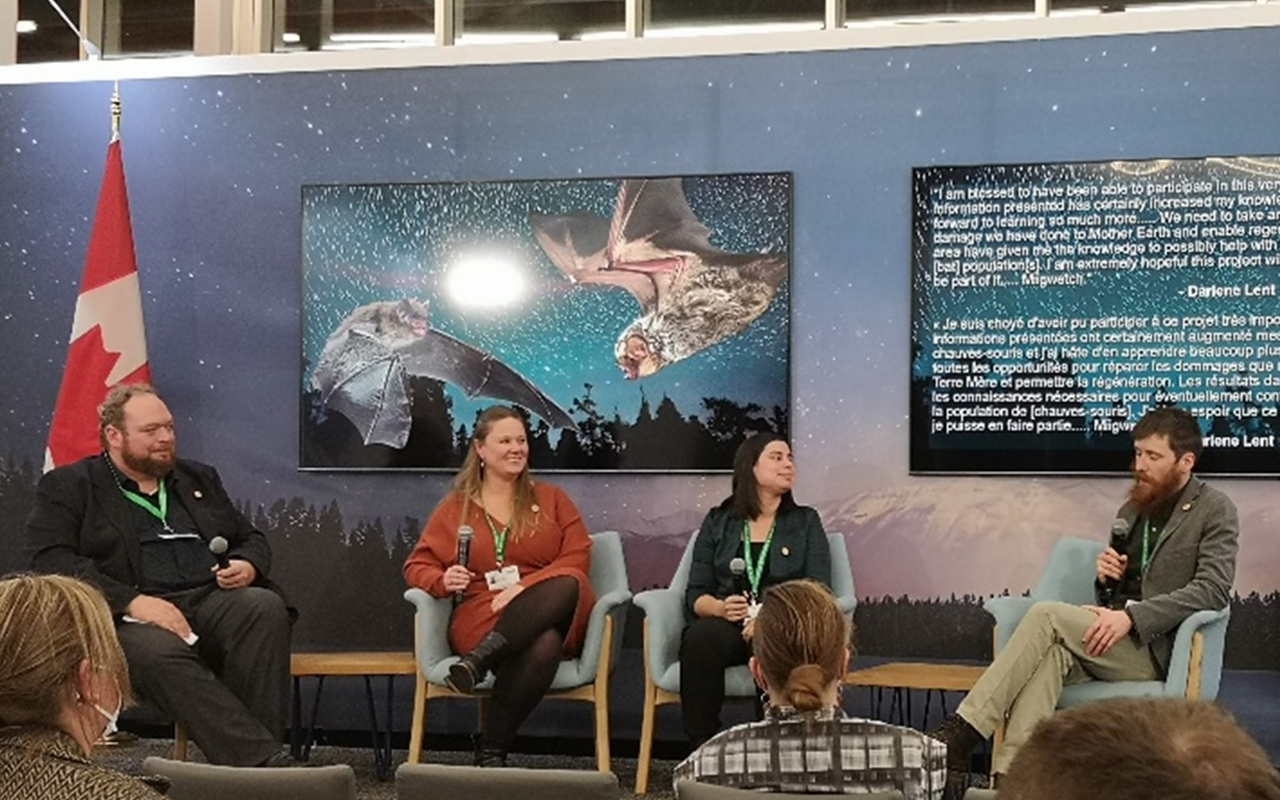Social, economic and cultural considerations
Brayden Moore, Assistant Engineer/Scientist at the NWMO, helped kids make their own borehole samples while he answered questions about geology at the White Otter Days celebration in Ignace, Ont., during summer 2022.
The NWMO’s commitment to any host communities and the surrounding area is that long-term well-being is fostered through participation in the project. This requires awareness and analysis of how the project may impact social, economic and cultural considerations in the siting areas, both during the site selection process and once a preferred site has been selected.
Over the past three years, the NWMO has contributed to community well-being in numerous ways through our activities. However, we also acknowledge that as people learn more about the project, we hear a range of perspectives emerging. We hear from people who support the project, people who oppose the project, and those who have not yet made up their mind.
The NWMO recognizes the potential for this range of opinions to cause tension within potential host communities. We continue to work with local leadership and community members to help address this issue through our engagement efforts, and by responding to community needs and providing fact-based information about the project.
Below you will find illustrative examples of the NWMO’s work that have impacted communities’ social, economic and cultural aspirations.
Capacity building
The NWMO works collaboratively with communities to build their capacity for participation in the project specifically, as well as more generally through transferable skills that could be applied to other projects or workplaces.
In the Saugeen Ojibway Nation (SON)-South Bruce area, the NWMO partnered with the Saugeen Valley Conservation Authority (SVCA) on the Water Well Improvement Program to protect local aquifers and drinking water sources. The NWMO has also partnered with the SVCA on field data collection for the environmental baseline monitoring program that monitors the physical environment in the region. The NWMO supported two water resource technicians to help implement the program.
Additionally, in the SON-South Bruce area, the NWMO partnered with the Métis Nation of Ontario and the Toronto Zoo to recruit and train 25 Métis citizens to become “community scientists” that aided in studies on biodiversity and endangered bats. In this project, citizens were provided with an opportunity to learn about bat conservation and scientific monitoring from experts with the Toronto Zoo Native Bat Conservation Program, while also learning about Canada’s plan for used nuclear fuel.
The NWMO’s partnership to protect endangered bats is showcased at the Canada Pavilion at the United Nations 15th Conference of the Parties (COP15) in Montreal, Que.
This partnership is an exemplary model for collaboration between industry, the scientific community, Indigenous peoples and local communities, working collectively to save and protect endangered bats in Ontario and to advance Reconciliation. In 2022, a joint presentation about this partnership was presented at the United Nations Biodiversity Conference (COP15) as an outstanding example of leadership in biodiversity conservation.
In the Wabigoon Lake Ojibway Nation (WLON)-Ignace area, the NWMO supported a number of First Nations through the BEAHR Indigenous training programs developed by Environmental Careers Organization Canada. This locally customized training is intended to provide Indigenous community members with introductory training for those seeking employment in the environmental sector.
The NWMO has also implemented an Early Investments in Education and Skills program, an ongoing initiative that is intended to assist communities in a manner that best suits their needs. Dozens of requests have been supported during the past three years, including:
- Business courses;
- First aid training;
- Robotics education;
- Student bursaries;
- Trades education; and
- Other STEAM (science, technology, engineering, arts and mathematics) initiatives.
Near-Term Investments in Community Social and Physical Infrastructure Projects
Over the past two years, the NWMO’s Near-Term Investments in Community Social and Physical Infrastructure Projects program has offered funding to communities for investments in “community readiness” projects, as they move into more intensive phases of study in the site selection process.
For example, in the Township of Ignace, this has included support for the redevelopment of the Ignace Shopping Plaza, as well as updates and expansion to a seniors’ walk and urban art trail. In the Municipality of South Bruce, this program has provided support for the development of the new Teeswater Medical Centre, a multi-use ice pad, the purchase of a fire pumper truck, and a landfill compactor. This program has also been provided to the core Indigenous communities in each siting area.
Supply chain
The NWMO is committed to working with municipalities, Indigenous communities and businesses to foster resilient, positive and mutually beneficial long-term relationships that will create social and economic opportunities. We also recognize that supplier development through procurement is a meaningful way to increase the diversity and capacity of the local business base in the siting areas. This could encourage business development and entrepreneurship, and bring jobs and wages to communities leading up to and beyond the selection of a site.
The recently completed borehole drilling programs in both siting areas are examples of the steps being taken to fulfil this commitment. Local firms were contracted to build and maintain access roads, supply water, remove wastewater, and provide fuel and solid waste disposal services. Additionally, drilling staff lived close to the drilling sites, purchasing food, gasoline and other supplies during their work in the area. This work was performed alongside Indigenous cultural monitors and guides to make sure land uses and culturally sensitive locations were protected.
Community studies and knowledge building
Beyond monitoring the ongoing effects of our work, the NWMO also takes social, economic and cultural considerations into account by undertaking studies that anticipate the potential future impacts of the project. As was recognized when Canada’s plan was initially developed, its implementation provides opportunities for capacity building, as well as contributions to the well-being of the communities.
For example, early studies showed that the project has the potential to align with the social, cultural, economic and spiritual aspirations of the potential host communities and siting areas. Further studies were required to confirm the potential contribution of the project in either siting area to the aspirations of the potential host communities, as expressed through their project visioning exercises.
The numerous studies the NWMO has completed help communities become more informed about local and regional community well-being, as well as environmental conditions and possibilities. Regardless of whether the project is sited in an area, the insights communities obtain from these studies provide a foundation for future community initiatives. We have also been working with the municipalities as they build up their understanding of Indigenous Knowledge and advance their Reconciliation journeys.
Lyndon J. Linklater is a Traditional Knowledge Holder and Storyteller from Thunderchild First Nation (Plains Cree) in Saskatchewan. He leads cultural awareness training for NWMO staff and communities in our potential siting areas.
In 2020, both the Township of Ignace and the Municipality of South Bruce participated in project visioning processes that involved engagement with the community. Questions, concerns and aspirations held by the community were identified and organized around five pillars of community well-being. In South Bruce, this process resulted in Council adopting 36 guiding principles.
Between 2021 and 2022, the Township of Ignace and the Municipality of South Bruce worked with the NWMO to complete a series of socio-economic community studies. The studies were designed to respond to the project visioning topics in Ignace and the 36 guiding principles in South Bruce.
In 2022, 34 social, economic and cultural studies were completed, covering topics such as:
- Labour and workforce;
- Housing;
- Infrastructure;
- Economic development;
- Health services and infrastructure; and
- Community and culture.
Each study describes current baseline conditions, identifies potential changes with the project, and assesses options to mitigate impacts or leverage opportunities within the communities. Community studies will be considered as part of the discussions around the draft hosting agreements that will define what partnership will look like.
These community studies involved distinct collaborative approaches between the NWMO and each municipality. In South Bruce, a collaborative peer review process was implemented. This entailed an ongoing review process for the full life cycle of the studies, from design through final reporting. Each study has an accompanying peer review report. The South Bruce studies, including the peer review reports, are available on the Municipality of South Bruce website.
In northwestern Ontario, an Ignace Area Working Group was established comprised of representatives from local and regional organizations and communities. The working group reviewed studies as these progressed, contributing local insight and knowledge, as well as feedback on option assessments. Each of these collaborative processes built shared knowledge and understanding about potential project impacts and options for the way forward. These studies are available through the Ignace Community Nuclear Liaison Committee website.
Safety and environmental assessments
In June 2022, the NWMO published Confidence in Safety reports for each of the two potential sites being considered to host a deep geological repository to safely manage Canada’s used nuclear fuel. The Confidence in Safety reports for both the SON-South Bruce area and the WLON-Ignace area will be used to support continuing dialogue with Canadians and Indigenous peoples about the project, including helping inform the communities that are considering their willingness to host the project.
Social, economic and cultural considerations are embedded in our safety assessments, including safety from a social perspective. Site-specific assessments are grounded within recognizable and relatable social contexts. We consider an expanded set of lifestyles in these assessments: town residents, rural residents, Indigenous lifestyles and a hunter-gatherer. The NWMO’s assessment analyses respond directly to concerns raised during discussions with community members. Additional assessment scenarios have been added to respond directly to concerns raised during discussions with community members.
The NWMO’s siting safety group are routinely available in our community offices, to share assessment outcomes in person and informally. This engagement helps us hear first-hand specific community questions, concerns, and sometimes, misunderstandings. We are working to improve the connections between safety assessment and the remaining siting communities, to build confidence around safety from a social perspective.
Environmental assessment work has also included social and cultural considerations. For example, prior to completing the sample design for the environmental baseline monitoring program, a number of workshops were led by the NWMO in both siting areas to gather right-holder and stakeholder input on the environment.
Protecting water quality was identified as a high priority, and many people expressed how important this is to them. As such, the regional surface water quality sample programs were designed in a participatory manner. Surface water is being collected from lakes or waterbodies identified as important to local right-holders and stakeholders.
Tulloch Environmental completed water well sampling at several properties in South Bruce, Ont., to better understand water quality.




